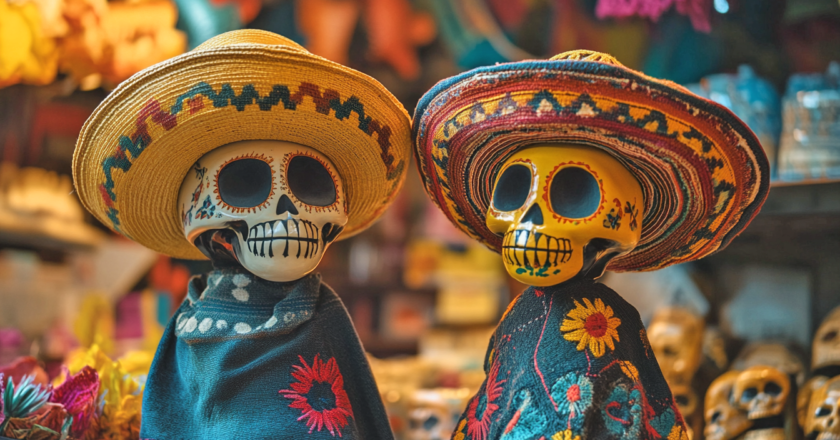BY THE UNKNOWN GRINGO
International Trade
I’m a docent at the Autry Museum of the American West where I take kids on tours during the school year. Usually grade school but sometimes older. No matter what age they are I always start my tour in front of the huge, stuffed bison / American buffalo we have. He’s visually impressive and I tell the kids how the native Americans would use the bison’s meat, bones, organs, sinew, hooves, leather, and fur to make food, tools, clothes, shoes, blankets, weapons, containers, and shelters called teepees. Nothing went to waste and the products they made were often traded far and wide with tribes that didn’t live in the Great Plains area.
The Pacific Coast natives, of course, harvested ocean fish and shellfish. There is evidence that the sea shells they collected were traded from tribe to tribe to tribe going eastward all the way into Nevada. Traded, eventually, to people that would never understand or see an ocean. The shells were used for beads, jewelry, ornaments, and fish hooks. They were an object of great prestige and could be considered a form of money because of that.
Does any of this apply to me or you? It sure does when some of my friends know I’m going to Mexico soon. They want me to bring back STUFF FOR THEM. The latest thing is Voltaren, an arthritis pain relief gel. They can easily get it here in the States but it is usually at 1% strength. In Mexico I can get it at Extra Strength of 2.32% AND at a better price than regular strength up north. I made the mistake of telling two friends I was doing this for one friend. Bingo, now I have three customers!!
Coffee. I get ground coffee for the woman who was my father’s wound care nurse and now feeds my beloved kitty when I am gone. I get her a wide range of beans from Chiapas, Oaxaca, and Veracruz. I tell her to save the empty bag of anything she wants more of. So far, she likes them all.
Cuban cigars. My mailman pushed me to do this many years ago. He didn’t want big fat ones. He wanted the small thin ones. I got him some, he said he liked them ……. and he wouldn’t pay me back. I kept reminding him. It took several months of me hounding him. He finally paid and then got transferred to another area of town. He was already off my list.
Olive oil. The oil made in the Guadalupe Valley by L.A.Cetto can be found at their winery in the valley, at their store in Ensenada, and sometimes at the large Calimax in Tecate. Again, I have three customers and packing 750ml bottles of olive oil on a motorcycle takes some delicate planning. (The Voltaren and coffee travel much easier.) Oddly enough, I haven’t even tried the local stuff because I buy small 250ml bottles of olive oil at Trader Joe’s.
Menthol cigarettes. Their getting banned in California in November, 2022 caused one desperate neighbor to ask me to get cartons of them EVERY TIME I went to Mexico. I had to turn him down. I did not want to have Customs at the border looking at me suspiciously and I wish there was no such thing as tobacco to harm good people. I would have felt guilty supplying him.
When I started going to Mexico over 30 years ago I would go to the first Costco that Tijuana had. This was years before Ensenada finally got one. I would see Americans buying DOZENS of cartons of American cigarettes and was told they sneak them back across the border because cigarettes made in the U.S. cost a lot less in Mexico because there is no tax on them there. They would hide them in their RV’s and make good money selling them to their friends back home. Help to pay for part of their vacation down south.
Mole. One year I sent surprise Christmas gifts to several friends that had salsa macha, Japanese peanuts, and mole in each box. Those packages went to friends in California, Utah, Oregon, and Alaska. The guy in Alaska sent me a desperate letter in return. Could I please send more mole because his estranged girlfriend loved the stuff and she was barely speaking to him even though they were still living together in the same house? Drama. That mole could solve? He got his wish but they remain “just friends”.
And this international trade goes in both directions. I have a buddy who works in a liquor store in Ensenada who asks me to bring un-baked buttermilk biscuits in a tube. Sure. Cheap, easy, small. Just pack them in a plastic bag in case a tube “blows”. No ruptures yet.
High-end American craft beer that isn’t exported down south. One guy swears the beer I brought him that’s made in Michigan is the best he’s ever tasted. For years I’ve given out my favorite IPA from Seattle to friends down there. It’s Elysian Space Dust IPA. The room I create for this stuff going south on my motorcycle makes room for olive oil going north.
Ice Cream. I tried taking Haagen-Dazs ice cream south ONCE over twenty years ago for a friend who works at my favorite hotel. With dry ice and lots of insulation in a cooler in my van. He had to rush it across the street to a restaurant’s freezer since it had turned too soft.
Drill bits. For a friend who worked in a gem shop and needed special drill bits for shaping his stones and minerals. A dear friend. Who never paid me back. I let it go because he was so much older than me and was probably struggling financially. I wrote about him before in the March 27, 2023 article about the Big Bottle of Mezcal – Part Two. He was almost a legend to me with all the stories he would tell me late at night over a bottle of mezcal about “lost Spanish gold mines, partnerships ending in murder, briefcases of money that would bring out the worst in men, eight foot tall human skeletons found in a cave, mining huge meteorites in the desert for big bucks, and how eating powdered rattlesnake helped him to please the ladies”. He’s passed now and when I go by his old shop I can get a little choked up. I wish I could buy him more drill bits.
A lot of things cross our border in both directions. People, ideas, music, food, products. Sometimes with conflict but also with convergence. International trade brings us closer. My motorcycle and I are a small part of that. I imagine most of you are.






